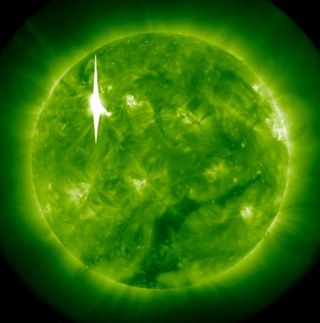Major Sun Storm May Supercharge Northern Lights This Week

A massive solar storm may spark an intense northern lights display for skywatchers at high latitudes tonight and Thursday (March 8) as a wave of charged particles reach the planet.
Two huge solar flares erupted from the sun late Tuesday (March 6), triggering one of the most powerful solar storms in more than five years. The solar tempest is expected to intensify aurora displays (also known as the northern and southern lights) on Earth, according to space weather scientist Joseph Kunches, of the National Oceanic and Atmospheric Administration (NOAA).
"Auroras are probably the treat that we get when the sun erupts," Kunches told reporters today (March 7).
One of the big sun flares unleashed a cloud of solar plasma and charged particles, called a coronal mass ejection (CME), into space. While the CME is not expected to hit Earth directly, the wave could deliver a glancing blow to the planet.
The CME, which is traveling at roughly 4 million mph (6.4 kph), is expected to reach Earth tomorrow morning at around 7 a.m. EST (1200 GMT), Kunches said. But, material could arrive at the planet as early as 1:25 a.m. EST (0625 GMT), plus or minus 7 hours, according to NASA scientists. [Photos of the big solar flares]
As the energetic particles impact Earth's magnetic field, aurora displays could be amplified for well-placed skywatchers around the world.
"Skywatchers at all latitudes should be alert for auroras," astronomer Tony Phillips wrote on his website Spaceweather.com, which regularly monitors space weather events.
Sign up for the Live Science daily newsletter now
Get the world’s most fascinating discoveries delivered straight to your inbox.
A bright, nearly full moon will also be competing for dominance, but provided the weather is clear, lucky skywatchers could be treated to spectacular aurora displays, Kunches said.
Still, auroras are not the only byproducts of solar storms. In fact, powerful flares and resulting CMEs can set off geomagnetic and solar radiation storms.
"Such a CME could result in a severe geomagnetic storm, causing aurora at low latitudes, with possible disruption to high frequency radio communication, global positioning systems (GPS), and power grids," NASA scientists said in a statement.
Geomagnetic and solar radiation storms sometimes have the power to disrupt communications and power grids on Earth, and interfere with satellites in space.
"There is the potential for induced currents in power grids," Kunches said. "Power grid operators have all been alerted. It could start to cause some unwanted induced currents."
Airliners with routes that fly over the polar caps could also experience communications issues during this time, and some commercial aircraft operators have already taken precautionary actions, he added.
Editor's note: If you snap an amazing photo of the northern lights sparked by these sun storms and would like to share it for a possible story or image gallery, please contact SPACE.com managing editor Tariq Malik at tmalik@space.com.
This story was provided by SPACE.com, a sister site to LiveScience. You can follow SPACE.com staff writer Denise Chow on Twitter @denisechow. Follow SPACE.com for the latest in space science and exploration news on Twitter @Spacedotcom and on Facebook.

Denise Chow was the assistant managing editor at Live Science before moving to NBC News as a science reporter, where she focuses on general science and climate change. Before joining the Live Science team in 2013, she spent two years as a staff writer for Space.com, writing about rocket launches and covering NASA's final three space shuttle missions. A Canadian transplant, Denise has a bachelor's degree from the University of Toronto, and a master's degree in journalism from New York University.
